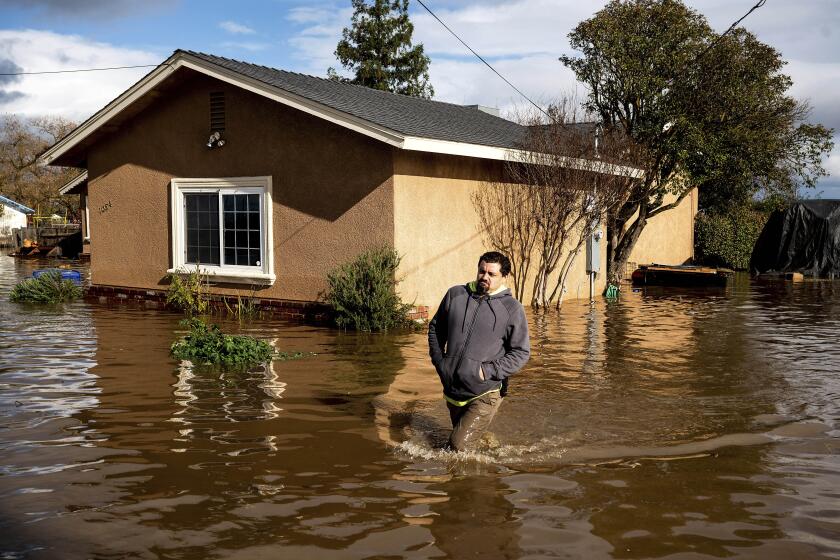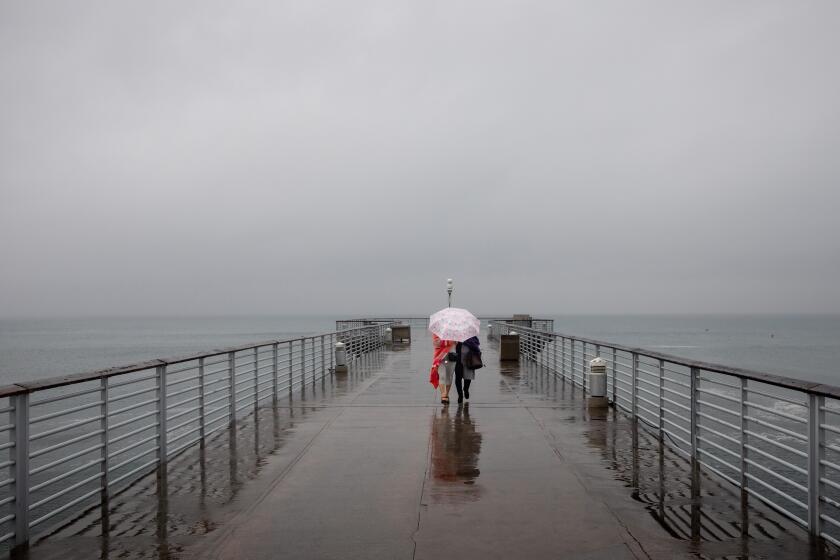Mass storm outages bring misery across California, exposing power grid’s vulnerabilities
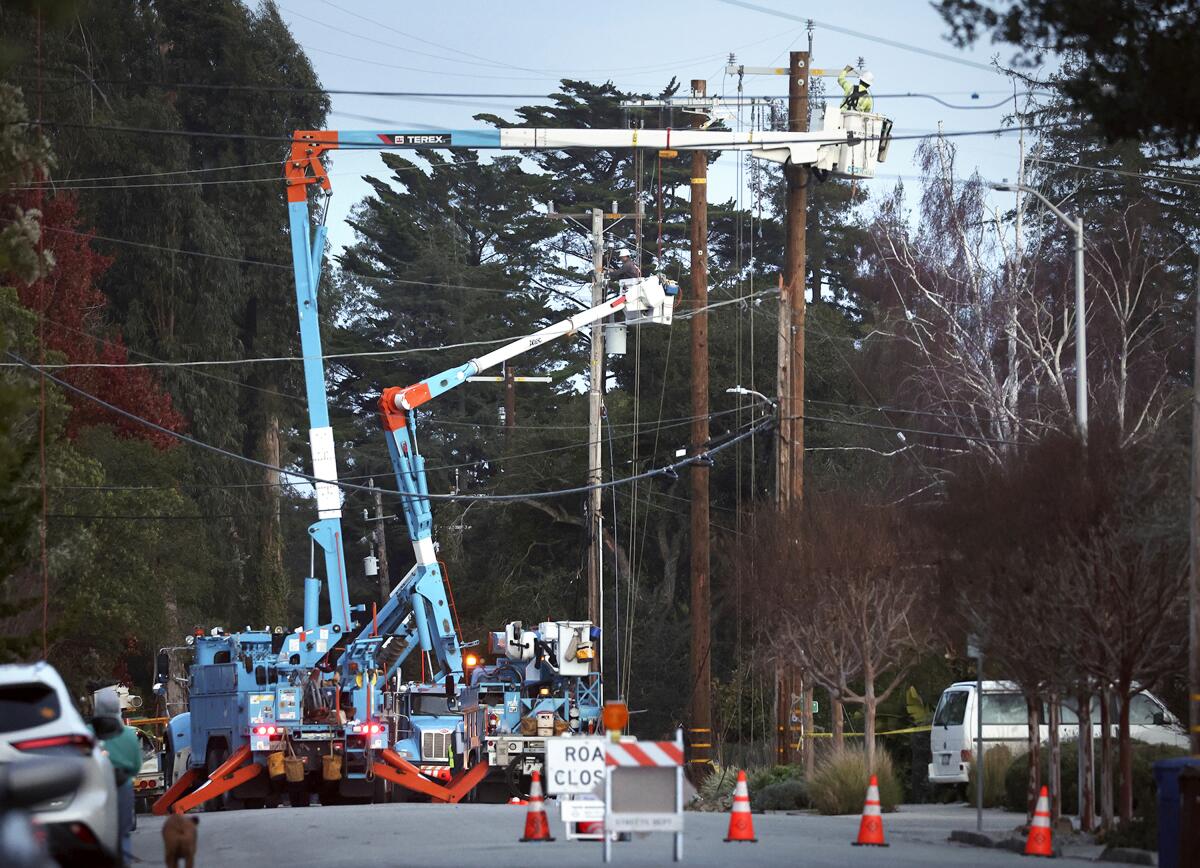
- Share via
David Higares was on his fourth day without power in his Morada home in San Joaquin County when he woke up to indoor temperatures barely above 50 degrees.
His lights had flickered twice since his neighborhood outside Stockton went dark Saturday, following one of the train of atmospheric river storms, but his home remained dark, he said. Each time he checked, it seemed Pacific Gas & Electric had again pushed back the estimate for restoring power.
“It feels endless at this point,” said Higares, who lost all the food in his refrigerator and freezer due to spoilage. “Basically, we’re camping indoors.”
Since New Year’s Eve, hundreds of thousands of Californians have lost power — many multiple times — as a string of severe winter storms has provided the latest glimpse into how extreme weather tied to climate change is challenging California’s power grid in unprecedented ways.
The seventh atmospheric river storm since Christmas was expected to hit California on Wednesday, and more flooding is possible through the weekend.
Increased stress on the electric grid has previously been most apparent in the summer and fall months, when wildfires have forced shutoffs to avoid lines sparking flames and during extreme heat when officials have requested customers limit power use during peak times.
But this powerful string of storms wreaked a new kind of havoc for utility providers, with heavy rains and high winds pummeling drought-stressed land, toppling trees onto power lines, knocking down support poles and blocking access to certain areas. At one point, more than 400,000 were without electricity, the vast majority in Northern California. For some, getting power back was a days-long ordeal. Others said they felt as if they were caught in a cycle of losing and regaining power.
“We expect, unfortunately, more weather extremes, more climate volatility — not just hotter in the summer, but more extreme weather in our winters,” said Mark Toney, executive director of the Utility Reform Network, which advocates on behalf of utility ratepayers. “Utilities [should be] viewing themselves as part of an ecosystem, if you will, of disaster preparedness.”
As the state looks for options to strengthen its power grid in the face of these more powerful storms, officials are running into some of the same challenges as when responding to extreme heat or fire dangers.
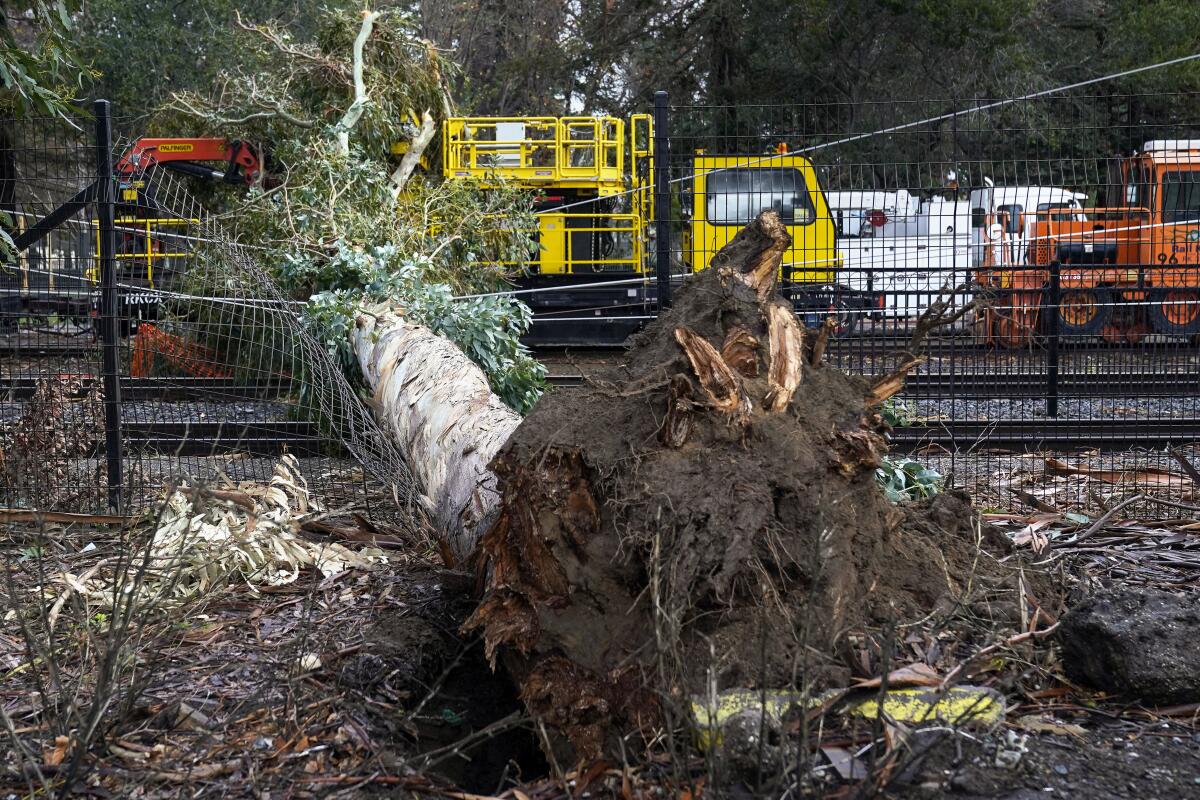
Options to make the power grid more resilient remain limited, and in many cases, come with a hefty price tag — a concern for Californians already facing some of the highest electricity costs in the nation.
“This is kind of the new normal, this is kind of what the climate crisis has brought us,” said Ric O’Connell, executive director of GridLab, a nonprofit focused on power grid transformation. He said California officials and utilities should be “thinking holistically about the system,” considering new technology and innovative ways that can provide more resilient energy sources even during crises.
PG&E, the state’s largest electricity provider, has plans to bury thousands of miles of lines to better protect against wildfires, which would also help eliminate risk from high winds or falling trees, experts said — but it’s one of the costliest alternatives. The plan is expected to cost at least $15 billion, and it only accounts for about 10% of PG&E’s transmission and distribution lines. Moving all the state’s power lines underground would be financially unsustainable, O’Connell said.
A NOAA expert thinks the costs of the atmospheric river hitting California could top $1 billion.
“It would literally cost trillions of dollars, so maybe that’s not the best approach,” O’Connell said, especially given the massive cost estimated for damage and recovery from this series of winter storms.
O’Connell pointed to other backup power options that could increase resiliency, such as leveraging green energy technologies, increasing local battery storage, forming more microgrids that operate separately and making better plans for how the most vulnerable can access power when the grid fails.
Given today’s climate patterns — swinging from extreme drought to extreme rains — it’s hard for grid operators and planners to adapt, and do so fast enough, said Sascha von Meier, a retired UC Berkeley professor now a consultant who focuses on electric grids.
“Those are not conditions that the system was designed for or engineered for,” Von Meier said, which is why she would like to see more outside-the-box energy planning, especially focused on renewables, their storage and transmission.
“We’re looking at radical, bigger picture” ideas, Von Meier said. “If we do it right, we’re going to build a lot of excess capacity of solar and wind generation.”
The atmospheric river due to hit California in the coming hours is likely to compound the damage wrought by a deadly storm on New Year’s Eve.
O’Connell pointed to projects such as the Blue Lake Rancheria tribe’s community microgrid that provides cleaner and more resilient energy for its rural community in Humboldt County, which is known for storms, earthquakes and fires.
Some of California’s utility providers have explored microgrid options, especially in remote areas, but O’Connell said there’s a need for more, especially when the grid is under almost constant stress.
Before the latest storms, PG&E, Southern California Edison and other utilities worked to minimize damage by tree-trimming and pre-positioning equipment and manpower in different areas based on forecasts, even calling in extra crews from out of state.
But the severity and duration of the storms meant there would be outages, experts said.
“We’ll have to look after the dust settles with this particular series of storms to see how well those preparations worked,” said Peter Larsen, the leader of the Electricity Markets and Policy Department at the Lawrence Berkeley National Laboratory. “The question is, were those preparations adequate, given what’s happening right now? ... The extent of the power disruption is pretty widespread.”
Seven consecutive atmospheric river storms have slammed the state since Christmas; first knocking out power for at least 100,000 on New Year’s Eve, mostly in the Sacramento area, then days later 170,000 were without power following a night of particularly strong winds in Northern and Central California, which PG&E officials at the time called “one of the most powerful storms in recent memory.”
A battery of January storms has blanketed the Sierra Nevada in extraordinary snowpack, but will it last through the winter?
Then Saturday, an even stronger storm left more than 400,000 without power statewide, with outages spanning dozens of counties from Humboldt to Los Angeles, in coastal towns up into the eastern Sierra.
Many Californians lost electricity multiple times; some found themselves without power for up to a week.
On Thursday, about 30,000 were still waiting for the lights to come back on, according to an online power outage tracker.
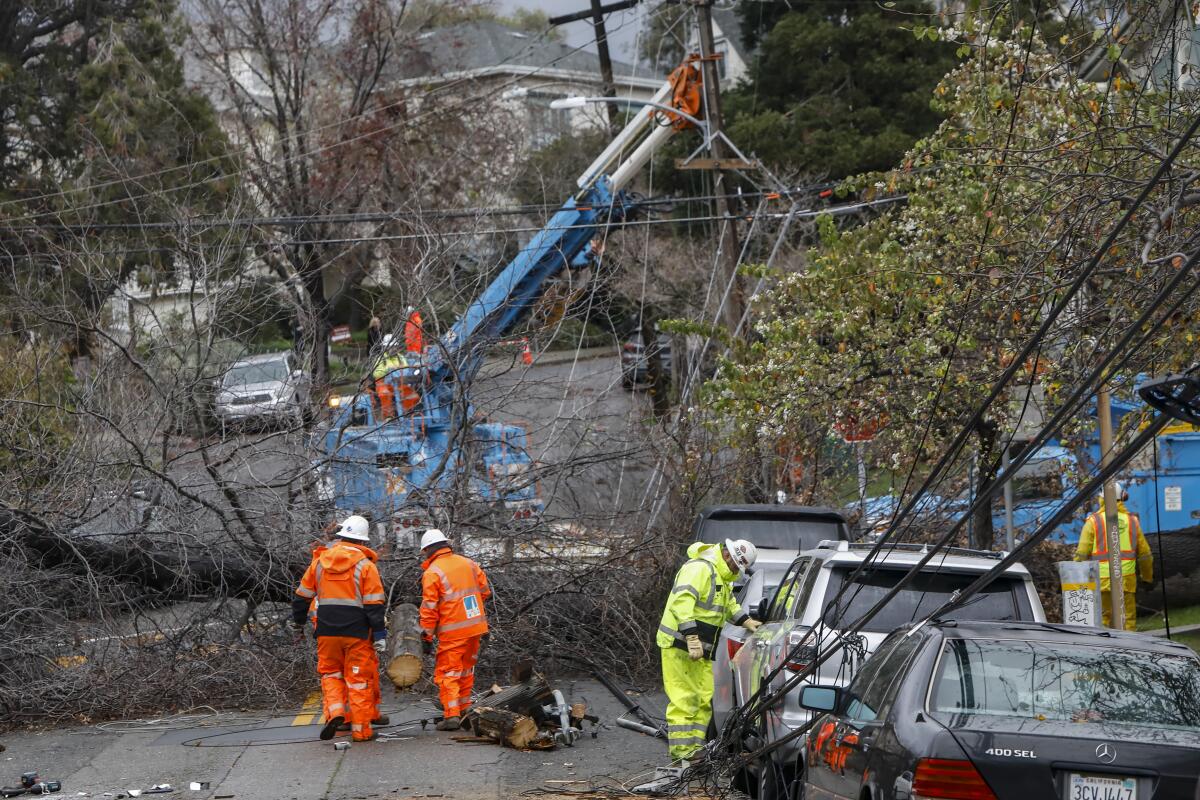
After three days without power during this latest storm series, Davis resident Richard McCann said he’s seriously considering implementing his own microgrid so he doesn’t have to rely on PG&E.
“I’ve been thinking about it,” he said. McCann, whose work focuses on power sector analysis, said his home lost power for about 48 hours beginning New Year’s Eve, then lost it again after Saturday for about 12 hours.
While the storms were severe across the state, McCann said Davis did not see unprecedented winds or flooding, adding to his concerns about the grid’s reliability.
He said he would like to see California’s utilities “distributing the system, so people can be more independent.”
“I think that’s probably a better solution rather than trying to build up stronger and stronger walls around a centralized grid,” McCann said.
For years, “hardening” the power grid has been the go-to solution for utilities — burying wires, strengthening and replacing poles, adding backup generators or replacing older equipment — but some electric grid experts said those efforts are often limited by time and money.
Toney said he expects the California Public Utilities Commission — the state’s regulatory and oversight board — to investigate the utility providers after these storms, looking at the extent and length of outages and ensuring that any price increases are necessary.
The commission said in a statement it has been “monitoring the situation” but did not answer questions about a possible investigation.
Higares, in San Joaquin County, said his power was eventually restored Wednesday afternoon, as PG&E’s massive recovery effort continued across the region.
He ended up buying a small generator as the outage dragged on, which could keep the fridge cold and provide a few outlets for charging electronics, he said, but without capacity for heat or other large appliances.
He’s hopeful the next storms — which forecasters warned could bring more issues this weekend — won’t mean more outages, but his expectations are low.
“I’ll enjoy a warm house while I can,” he said. “There’s a lot of people that are in way worse situations than me ... but it’s frustrating.”
More to Read
Sign up for Essential California
The most important California stories and recommendations in your inbox every morning.
You may occasionally receive promotional content from the Los Angeles Times.
